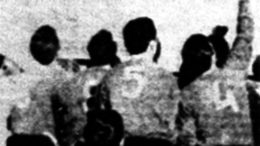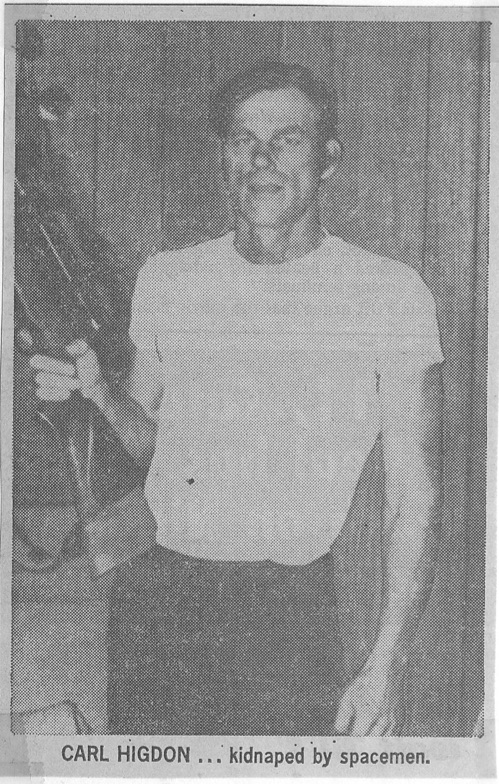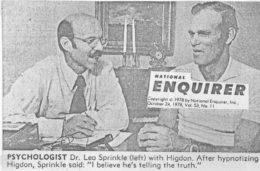by Charles Lear
 Back in the days before aliens took on the form of the standardized “Grey” model, they came in all shapes and sizes. UFOlogists called them “humanoids,” and there was a wave of them in France in 1954. In 1955 they started popping up in the United States and worldwide. Many UFOlogists, who were trying to convince the scientific community that the mystery was worth studying, tended to reject humanoid reports. Some, such as Coral and Jim Lorenzen of the Aerial Phenomena Research Organization, kept an open mind as long as the humanoids didn’t talk. If a witness reported they had had a conversation and were taken to another planet, that case was tossed into the contactee pile. However, there was a case in the seventies that made the Lorenzens and a lot of other researchers rethink their position.
Back in the days before aliens took on the form of the standardized “Grey” model, they came in all shapes and sizes. UFOlogists called them “humanoids,” and there was a wave of them in France in 1954. In 1955 they started popping up in the United States and worldwide. Many UFOlogists, who were trying to convince the scientific community that the mystery was worth studying, tended to reject humanoid reports. Some, such as Coral and Jim Lorenzen of the Aerial Phenomena Research Organization, kept an open mind as long as the humanoids didn’t talk. If a witness reported they had had a conversation and were taken to another planet, that case was tossed into the contactee pile. However, there was a case in the seventies that made the Lorenzens and a lot of other researchers rethink their position.
 On Oct. 25, 1974, Rawlins, Wyoming resident Carl Higdon decided to take the day off from his job as foreman for an oil drilling crew. One of his “key men” was sick with the flu and he didn’t think anything would be accomplished that day. It was the peak of elk hunting season, and he had just bought a 7mm Remington Magnum rifle, so he probably didn’t have to think for too long about how he would be spending the day. He loaded up his company’s two-wheel drive pickup truck and headed for McCarty Canyon in Carbon County.
On Oct. 25, 1974, Rawlins, Wyoming resident Carl Higdon decided to take the day off from his job as foreman for an oil drilling crew. One of his “key men” was sick with the flu and he didn’t think anything would be accomplished that day. It was the peak of elk hunting season, and he had just bought a 7mm Remington Magnum rifle, so he probably didn’t have to think for too long about how he would be spending the day. He loaded up his company’s two-wheel drive pickup truck and headed for McCarty Canyon in Carbon County.
According to him, he came to a fork in the road leading into the canyon and saw some fellow hunters having battery trouble with their truck. He stopped to give them a charge, and they started talking. Higdon told them he was headed into the canyon, and they told him that the hunting was better in a remote section of Medicine Bow National Forest. He changed his plans and headed east. The area they told him about was in the northern section of the forest, 40 miles south of Rawlins.
He got there at around 4:00 p.m. and was surprised to see a friend there, Gary Eaton. Eaton told Higdon that he was headed to higher ground and joked that he might scare some elk down for him. They separated, and after walking deep into the forest, Higdon spotted a small herd of elk.
 He took aim at a three-point bull and fired. He was braced for the gun’s characteristically strong kickback, but there was none. There was no sound of firing, and he recalled that it was as if the entire world had gone silent. He watched the bullet leave his gun in slow motion, travel for approximately 50 feet, and then fall to the ground. He noted that the air felt like it was charged with static electricity.
He took aim at a three-point bull and fired. He was braced for the gun’s characteristically strong kickback, but there was none. There was no sound of firing, and he recalled that it was as if the entire world had gone silent. He watched the bullet leave his gun in slow motion, travel for approximately 50 feet, and then fall to the ground. He noted that the air felt like it was charged with static electricity.
He went and picked up the bullet, which was mangled and missing its lead. As he put the bullet in his canteen pouch, he heard a branch snap. He turned and saw what looked like a man, but he quickly realized it was unlike any man he’d ever seen or heard of.
The creature was about six feet tall and bow-legged. It had straw-like hair that stood straight out, with two strands in front that looked like antennas. It had no ears that he could see or eyebrows. Its face was yellow and went straight into its neck with no chin, and it had a lipless mouth with three big teeth in the upper and lower jaw. It was dressed in what looked like a black diving suit with crossed straps over the chest and a belt with a yellow six-pointed star. Its right arm ended in a point and its left arm ended bluntly with no sort of appendage.
The creature asked, “How you doin?” In spite of his fear, Higdon managed to respond and said, “Pretty good.” The creature asked if he was hungry. Higdon said, “Yeah, a little.,” and the creature sent a package of cellophane-like material containing four pills floating through the air towards him. The creature told him to swallow one and that it would satisfy his hunger for four days. Higdon did so without thinking. He normally didn’t take pills, not even aspirin.
 The creature introduced itself as “Ausso One,” and Higdon caught sight of a transparent, rectangular object about five feet tall, seven feet long, and four and a half feet wide. Ausso One asked, “Do you want to come along?” Higdon said, “Yeah, I guess.,” and in an instant, he found himself inside strapped to a chair. The inside seemed impossibly spacious, and he saw five elk in there with them that appeared to be paralyzed.
The creature introduced itself as “Ausso One,” and Higdon caught sight of a transparent, rectangular object about five feet tall, seven feet long, and four and a half feet wide. Ausso One asked, “Do you want to come along?” Higdon said, “Yeah, I guess.,” and in an instant, he found himself inside strapped to a chair. The inside seemed impossibly spacious, and he saw five elk in there with them that appeared to be paralyzed.
Another being appeared and the two creatures put a helmet on Higdon’s head that had wires sticking out in all directions. Soon, he saw a sphere below. They landed on what he assumed was their planet, and Ausso One told him they were “163,000 light miles from Earth.”
Higdon saw a structure that reminded him of the Space Needle in Seattle. There were revolving multi-colored lights all around it that were so bright, they burned his eyes. He shouted at them to shut them off, and one of the creatures told him, “Your sun burns us too.”
He was taken inside the structure, and a clear screen was put in front of him. Ausso One was behind the screen as if he was using it to examine him. He then told Higdon that they were going to take him back because he “didn’t suit their purpose.”
He was suddenly back in the “ship” with no idea how he got there. Ausso One was admiring his rifle and handed it back wistfully, saying he was not allowed to keep his “primitive weapon.” He took back the pills, telling Higdon he would no longer need them, and that was Higdon’s last memory before finding himself back on Earth.
He saw his truck, which was now about three miles away from where he had parked it. Higdon realized he was floating over the ground and Ausso One said, “We’ll see you.” The object left and Higdon dropped onto a ledge, slipped on a loose rock, and fell about ten feet hurting his head and shoulder.
Totally disoriented, he struggled along a dirt road and then returned to the truck for shelter without realizing it was his. He had no idea who he was or where he was.
At around 6:30 p.m. he heard a voice over the CB radio. It was a woman from the company office in Riverton talking to someone else, and he cut in and asked for help. Roy Fleming was put on. He asked Higdon where he was, and Higdon told him that he saw a sign that said “North Boundary Lincoln Forest.”
A search party was organized that consisted of Carbon County Sheriff Charles Ogburn, Deputy Sheriff Ed Tierney, and some experienced hunters. In several four-wheel drive vehicles, they struggled on primitive, muddy roads to get to Higdon. When they finally found the truck at around 11:30 p.m., they had no idea how he could have gotten there. The truck was fender deep in mud and there were no tracks leading to it. It had to be towed out.
Higdon was taken to Carbon County Hospital in Rawlins and was examined by Dr. Russ Tongco. Higdon had amnesia and red, constantly watering eyes. He complained about the lights and they were turned off. He was kept in the hospital until he eventually recovered his memory. Strangely, the scars on his lungs from a bout of tuberculosis had disappeared, his kidney stones were gone, and his blood was especially nutrient rich.
Once he was home, Higdon got a call from Sue Taylor, a reporter at the Rawlins Daily Times. He told her his story, with a full awareness of how bizarre it sounded. It was published in the Oct. 29, 1974 edition of the paper.
 Rick Kenyon, a Rawlins Public School art teacher, interviewed Higdon and made drawings based on his description of Ausso One. Kenyon put him in touch with Dr. Leo Sprinkle, a psychologist and a consultant for APRO, who would later work on the Travis Walton case.
Rick Kenyon, a Rawlins Public School art teacher, interviewed Higdon and made drawings based on his description of Ausso One. Kenyon put him in touch with Dr. Leo Sprinkle, a psychologist and a consultant for APRO, who would later work on the Travis Walton case.
Sprinkle hypnotized Higdon and more details came out, including seeing other humans in the building he was taken into. The important thing to note is that all of Higdon’s recollections above, other than the “examination” and his falling off the ledge, were conscious memories while in a non-hypnotic state.
Higdon’s wife Margery had found the bullet, and for reasons she was unsure of, had a professional photographer take pictures of it. It was later examined by an APRO consultant, Dr. Walter Walker. It was turned inside out, which would have taken tremendous force, as a 7mm bullet can normally penetrate a telephone pole with ease.
Higdon’s story has been told worldwide and was featured in an episode of “In Search Of.” The Lorenzens thought enough of it to make it the front-page story in the March 1975 APRO Bulletin.
Sprinkle submitted a report to the National Investigations Committee on Aerial Phenomena. It was addressed to Linda Kieffer, the editor of NICAP’s publication, the UFO Investigator. Kieffer chose not to print the story, and NICAP had a long history of rejecting such cases. There is an “Editor’s Response” in the Nov. 1974 edition addressing complaints that “THE UFO INVESTIGATOR [sic] does not print enough ‘contactee’ cases and is not printing ‘sensational’ reports.” She explained that researchers had struggled over the years “to remove the image of ‘little green men with antennae.’” Apparently it didn’t matter that Higdon’s “men” were six feet tall and yellow.
Special thanks to David Marler for providing the Center for UFO Studies file on this case from his archives.
Margery Higdon published a book in 2017 about her husband’s experience, “Alien Abduction of the Wyoming Hunter.”
I wonder if Higdon’s appetite returned only three days after he ate the nutrient pill.